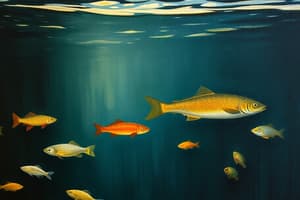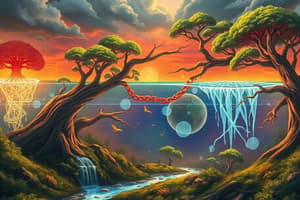Podcast
Questions and Answers
What does a pyramid of biomass illustrate in an ecosystem?
What does a pyramid of biomass illustrate in an ecosystem?
- The types of species present
- The relative amount of living organic matter at each trophic level (correct)
- The total number of organisms
- The energy available at each level
What is the percentage of energy available from one trophic level to the next?
What is the percentage of energy available from one trophic level to the next?
- 5%
- 50%
- 10% (correct)
- 20%
In most ecosystems, how does the pyramid of numbers usually relate to the pyramid of biomass?
In most ecosystems, how does the pyramid of numbers usually relate to the pyramid of biomass?
- The pyramid of numbers is inverted
- They are the same shape (correct)
- The pyramid of numbers is larger
- They are completely unrelated
Why might a pyramid of numbers be inverted in some ecosystems?
Why might a pyramid of numbers be inverted in some ecosystems?
What primarily determines the amount of biomass a given trophic level can support?
What primarily determines the amount of biomass a given trophic level can support?
What happens to energy stored in body tissues when one organism eats another?
What happens to energy stored in body tissues when one organism eats another?
How does energy flow through ecosystems?
How does energy flow through ecosystems?
What defines a food chain?
What defines a food chain?
In the food chain example from the Everglades, who is the top carnivore?
In the food chain example from the Everglades, who is the top carnivore?
What is a characteristic of a food web?
What is a characteristic of a food web?
Which of the following accurately describes primary producers in aquatic food chains?
Which of the following accurately describes primary producers in aquatic food chains?
Why is the food web a more accurate representation of ecosystems than a food chain?
Why is the food web a more accurate representation of ecosystems than a food chain?
How many steps are involved in the food chain presented in the Everglades example?
How many steps are involved in the food chain presented in the Everglades example?
What does a pyramid of energy indicate about energy transfer between trophic levels?
What does a pyramid of energy indicate about energy transfer between trophic levels?
What type of ecological pyramid illustrates the amount of living organic matter at each trophic level?
What type of ecological pyramid illustrates the amount of living organic matter at each trophic level?
Why are there typically a limited number of trophic levels in a food chain?
Why are there typically a limited number of trophic levels in a food chain?
Which statement accurately describes a pyramid of numbers?
Which statement accurately describes a pyramid of numbers?
What are primary producers in an ecosystem?
What are primary producers in an ecosystem?
What happens to most of the energy that organisms acquire?
What happens to most of the energy that organisms acquire?
Which ecological pyramid would you consult to understand the distribution of energy in a food web?
Which ecological pyramid would you consult to understand the distribution of energy in a food web?
What role do decomposers play in an ecosystem?
What role do decomposers play in an ecosystem?
What percentage of energy from one trophic level is typically available to the next level?
What percentage of energy from one trophic level is typically available to the next level?
How do detritivores fit into the food web?
How do detritivores fit into the food web?
What is the main distinction between a food chain and a food web?
What is the main distinction between a food chain and a food web?
What happens to nutrients when organisms die, and decomposers are present?
What happens to nutrients when organisms die, and decomposers are present?
What can occur following a disturbance in a food web?
What can occur following a disturbance in a food web?
How would a significant drop in krill populations affect aquatic food webs?
How would a significant drop in krill populations affect aquatic food webs?
What do ecological pyramids illustrate?
What do ecological pyramids illustrate?
What might result from nutrients remaining locked in dead organisms?
What might result from nutrients remaining locked in dead organisms?
Flashcards are hidden until you start studying
Study Notes
Energy Flow
- Energy flows through an ecosystem in a one-way stream, from producers to various consumers.
- Food chains are a series of organisms that transfer energy by eating and being eaten.
- Each step in a food chain is called a trophic level.
- Primary producers make up the first trophic level.
Food Chains & Food Webs
- An Everglades food chain example: Phytoplankton and attached algae are eaten by flagfish, which are eaten by largemouth bass, which are eaten by anhinga, which may be eaten by an alligator.
- Food webs are networks of feeding interactions that link all food chains in an ecosystem.
- Detritus pathway: Decomposers convert dead material to detritus, which is eaten by detritivores, such as crayfish, grass shrimp, and worms.
- Decomposers break down dead and decaying matter into forms that can be reused by organisms.
- Disturbances to food webs can have dramatic effects.
Trophic Levels & Ecological Pyramids
- Ecological pyramids show the relative amount of energy or matter contained within each trophic level.
- There are three types of ecological pyramids: pyramids of energy, pyramids of biomass, and pyramids of numbers.
Pyramids of Energy
- Only a small portion of energy that passes through a given trophic level is stored in the bodies of organisms at the next level.
- Organisms expend much of the energy they acquire on life processes, such as respiration, movement, growth, and reproduction.
- On average, about 10 percent of the energy available within one trophic level is transferred to the next trophic level.
Pyramids of Biomass & Numbers
- Biomass is the total amount of living tissue within a given trophic level.
- A pyramid of biomass illustrates the relative amount of living organic matter at each trophic level.
- A pyramid of numbers shows the relative number of individual organisms at each trophic level.
- The shape of the pyramid of numbers can be inverted, especially when small organisms are numerous compared to larger ones.
Review: Difference Between Food Chains and Food Webs
- A food chain is a single pathway of energy transfer through feeding relationships.
- A food web is a complex network that shows all possible feeding relationships in an ecosystem, linking multiple food chains together.
Studying That Suits You
Use AI to generate personalized quizzes and flashcards to suit your learning preferences.




